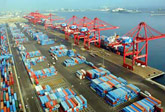 |
Container traffic through the largest US seaport complex in September continued to show big year-over-year gains, with the Port of Los Angeles showing a 22 percent increase and the Port of Long Beach recording a 30.5 percent rise.
But the figure for the Los Angeles port was off about seven percent from August this year, when monthly container traffic reached its highest level in four years. At Long Beach, September traffic was off about six percent from August, when it had hit its highest level since November 2007.
The West Coast ports account for about 40 percent of US inbound container traffic, loaded mostly with consumer products and other goods from Asia, reported Dow Jones Newswires.
The National Retail Federation said last week that it expected imported container traffic to slowdown in September from August but anticipated solid year-over-year increases to continue.
"While October has long been the busiest month of the year as retailers rush to fill shelves with merchandise for the holiday season, the peak shifted to August this year," the retail trade group said.
Loaded inbound containers through the Los Angeles port numbered 373,249 last month, up nearly 21 percent from the year-ago period but off 6.5 percent from August. A total of 288,905 loaded inbound containers came through the Long Beach port last month, up more than 28 percent from a year earlier but down about seven percent from August.
Outbound containers, or US exports, totalled 139,800 at Los Angeles, down 0.3 percent from the year-ago period and down five percent from August. At Long Beach, loaded outbound containers numbered 124,021, up more than 13 percent from a year earlier but off 1.6 percent from August.
Both ports handled large amounts of empty containers in both September and August, as shippers continued to return empties to Asia to address capacity shortages.
Empty containers shipped through the Los Angeles port came in at 198,563 last month, up 48 percent from the year-ago period. Long Beach empties numbered 161,864, up 53 percent from a year ago.
Cargonews Asia
|












